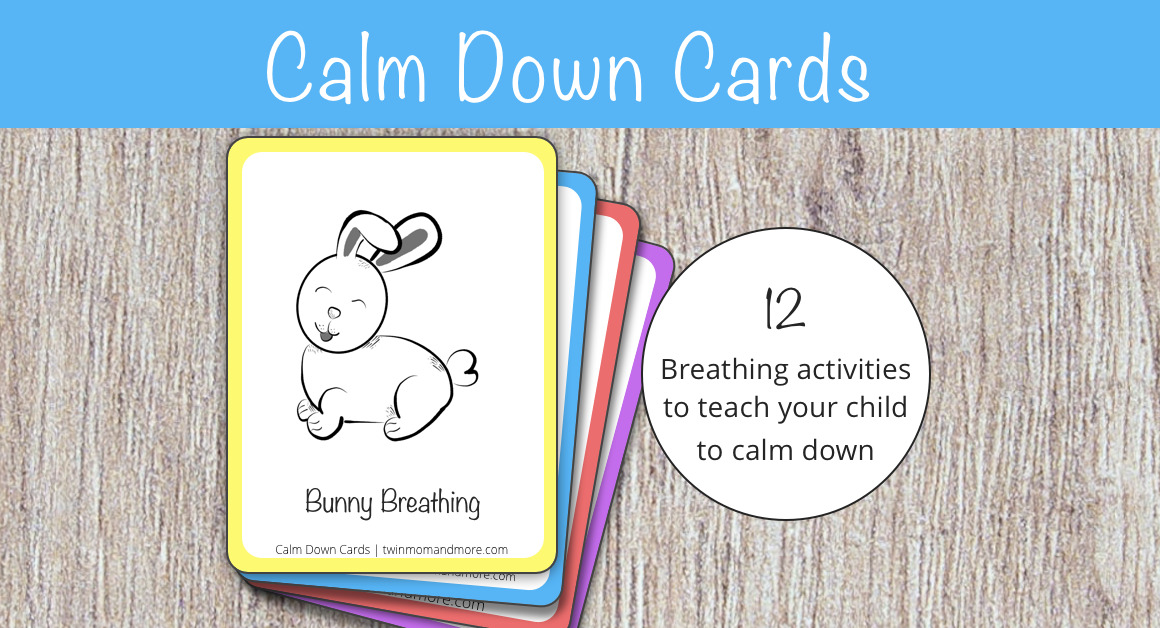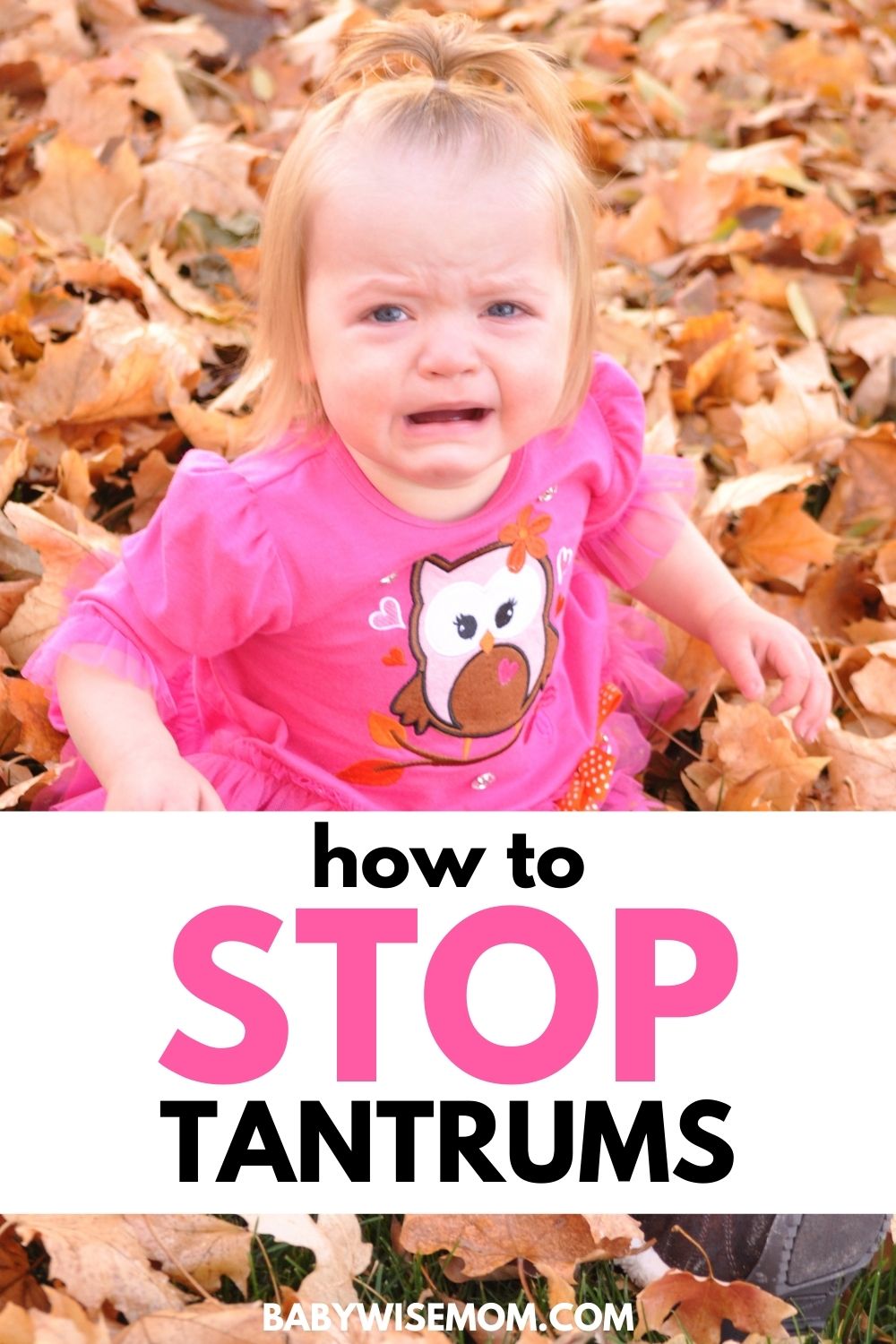How to Deal with Toddler Tantrums. What to do in the moment when your toddler is having a tantrum and how to prevent toddler tantrums in the future.

Toddler tantrums can be intense.
Here you have this sweet little person who has so far really only cried when physical needs haven’t been met.
Sure, there have been a couple of times some crying has happened when the child didn’t get her way, but for the most part, it has been benign.
Then the toddler years come.
Toddler tantrums can leave you speechless and scrambling to try to figure out how to react and what to do.
You don’t want to give in to the demands, but you don’t want the screaming to continue, also.
You will feel an extra layer of panic if your toddler is having a public tantrum.
Tantrums are normal. You should expect them as part of healthy child development. That is the good news.
When your toddler has a tantrum, it doesn’t mean there is something wrong with her.
“The propensity of throwing temper tantrums is a normal phase of development” (On Becoming Toddlerwise
You will be better able to handle a toddler tantrum in a way you are happy with if you have a game plan before the tantrum happens.
Let’s discuss some key points.
Post Contents
- How to Deal with Toddler Tantrums
- Understand Your Main Goal
- Give Clear Instructions
- Maintain Your Composure
- Do Not Reason with Toddler
- Hug Your Toddler
- Be Aware of Sleep and Hunger Needs
- Work on Language Skills
- Have Respect for Toddler’s Feelings
- Use Distraction and Substitution
- Have Consequences
- How To Stop a Tantrum
- 1-Lighten the Mood
- 2-Mimick Your Child
- 3-Have Daily Independent Play Time
- 4-Remain Calm and Basically Remain Unimpressed
- 5-Express Empathy
- 6-Redirect
- 7-Get Your Child’s Attention
- 8-Have Your Child Take a Breath
- 9-Tell Your Child To Stop
- How to Prevent Toddler Tantrums
- Practice Having Delayed Gratification
- Train in Times of Non Conflict
- Analyze Freedoms of Toddler
- Have a Solid Schedule
- Teach Your Toddler to Be Flexible
- Conclusion
- Related Posts
- Reader Comments and Questions
How to Deal with Toddler Tantrums
Here are some tips and key strategies to remember when your toddler has a tantrum.
Understand Your Main Goal
As a parent, your goal is to help your child develop life skills.
When your child has a tantrum, you don’t want the tantrum to stop simply because you find the screaming and stomping annoying.
You want your child to learn to manage feelings and emotions in a less abrasive manner.
Keep your main goal in mind.
That helps you avoid credit card parenting.
You aren’t trying to simply mask the behavior; you want to get to your child’s heart and train her to respond better when she is upset.
Give Clear Instructions
Do not give instructions that end in questions.
For example, you don’t say, “Get your shoes on, okay?”
Okay gives room for a “no” in response, whether a verbal no, ignoring you, or throwing a fit.
“Please get your shoes on!” is better.
Even better than that is “Please get your shoes on. Say ‘Yes Mommy’!”
>>>Read: How to Get Your Child to Obey with a Simple “Yes Mom”
Maintain Your Composure
When your toddler is having a tantrum, always work to maintain your composure.
If you lost your temper, you are effectively having an adult version of a tantrum.
You can’t expect your toddler to keep her cool if you cannot keep your cool. Be sure you maintain your composure so you set a good example for your child. A mom tantrum doesn’t teach your kiddo to not thrown her own fit.
You also want to maintain your composure so you can think straight.
You want to be able to stop and think before you respond (see When Your Child Has a Tantrum, Stop and Think for more).
That way, your response can be intentional and rational.
Do Not Reason with Toddler
A toddler having a tantrum is not a rational being.
There will be some toddlers who are super logical people. You might be able to reason with those toddlers in the heat of the moment.
For most, however, you cannot lean on your toddler’s logical side chilling out and snapping out of it.
During a fit, your kiddo is experiencing a rush of emotion.
You need to have your response and your consequences without trying to sit and talk things out with your toddler.
Hug Your Toddler
Sometimes a tantrum can be soothed with a hug. When you take that child in your arms and simply hug the toddler, she might be able to calm down and stop having a tantrum.
Be Aware of Sleep and Hunger Needs
If a child is hungry or tired, meltdowns are more likely. Make sure you address hunger and make sure you aren’t always skipping nap time. If you find your kiddo has major breakdowns when it is time to eat or sleep is in a deficit, work to prevent that in the future.
If you are out running errands or getting groceries, have a snack with you. Avoid going out over naps or past bedtime.
Work on Language Skills
A child who cannot communicate is more likely to have fits. The better your child can communicate with you, the fewer fits you will see. Read more in my post The Screaming Non-Verbal Baby/Toddler.
Have Respect for Toddler’s Feelings
A tantrum is often an intense emotional response to something not going the toddler’s way.
Respect that your child has feelings and it is okay to have feelings. It isn’t necessarily okay to express those feelings by having a raging fit, but the feelings are okay.
A helpful thing to do is repeat your toddlers frustrations or feelings.
“You don’t want to go home right now. You want to stay and play. You feel sad that we are leaving.”
Saying those things helps your child realize you do understand why she is upset. Sometimes the fit is made worse because your little one is sure you don’t get it, so if you can demonstrate that you do, it can help her calm down.
Read: Big Feelings: Talking Through Tantrums With Your Child from Team Cartwright
Use Distraction and Substitution
Distracting your toddler or giving an alternate to what she wants to do are a couple of great ways to stop a tantrum from happening.
These tools can at times feel like you are not really addressing the root of the problem with the tantrum.
In the moment, do not be afraid to use these tools to help with the tantrum. If you feel like there are bigger issues at hand, read up on the ideas in the “How to Prevent Toddler Tantrums” below.
>>>Read: Distraction as a Discipline Tool and How to Use Substitution for Toddler Discipline for more.
Have Consequences
When your child has a tantrum, you will want to have some consequences in mind.
Remember your goal; you are trying to help your child learn to respond to that disappointment, anger, etc. through other ways.
You might have a time out until your child can get things under control. Your child might lose a toy, privilege, or freedom.
How To Stop a Tantrum
I just went over many important concepts to keep in mind when dealing with a tantrum. Now let’s discuss a basic plan for how to stop it.
There are stratgies for stopping the fit right in its tracks.
These are all methods I use to stop a tantrum.
I don’t do each one each time and I don’t do any special order.
You kind of have to feel it out and go with what you think seems best at the moment. You will find some methods are more effective for different children or different ages.
1-Lighten the Mood
My most common thing to do when I have a little one starting a fit is to lighten the mood.
I tickle. I joke. I get them laughing.
You don’t have to respond to tantrums with a firm, stern face.
What you don’t want to do is give in to the tantrum.
So say your child starts throwing a fit because she wants to watch TV and you have told her no. You might start tickling her to get her to “turn that frown upside down,” but you still don’t turn the TV on.
The rule stays, the attitude changes.
2-Mimick Your Child
Mimicking seems to work best for the older toddler on into preschooler age range. Sometimes younger toddlers will stop with mimicking, too.
Your child starts that fit and you join right in (though I don’t think I ever match the magnitude).
This is an extension of my suggestion to lighten the mood.
Watching an adult throw a tantrum is quite entertaining. Then the child sees how silly it looks and usually goes from mid-cry to laughter.
3-Have Daily Independent Play Time
Sometimes a child just needs to be alone. If your child is having a super grumpy day, do an extra session of Independent Play. Or make sure to get your one session in there.
I often found if Brinley is having a grumpy morning, she will come out of Independent Play quite pleasant.
Brayden also always needed his independent playtime. Otherwise, he was less obedient and more likely to have a fit.
4-Remain Calm and Basically Remain Unimpressed
As your child throws a tantrum, continue on with your business. If you weren’t doing anything, find something to do.
Wipe the counter off if you can think of nothing else. Fluff some pillows.
Continue on as though that tantrum isn’t phasing you in the least.
Your child often wants some sort of reaction from you. If you react with some strong emotion, your child will feel a bit vindicated.
You basically ignore the fact that a fit is happening.
5-Express Empathy
Sometimes your child needs you to pick her up and hold her and empathize. “I know you really wanted to watch a show. You can’t right now, but I know you are disappointed about it.”
6-Redirect
Redirection can work for any age. Young toddlers can be physically moved to a better location or activity.
Toddlers and young preschoolers can be directed to new activities.
Preschoolers and children can be given a list of other options to choose from.
As your child gets older, you can encourage personal problem solving by helping your child brainstorm what to do. “No, you cannot watch a show right now. Can you think of a different activity you could do instead?” (and if they try to pull the “nothing” thing, see this post: Discipline Phrase: “Just Sit and Be Bored”).
7-Get Your Child’s Attention
If you are going to communicate with your child, you need to get your kiddo’s attention.
This is why the “yes Mommy” is a powerful tool.
You will say your child’s name and expect a “yes, mommy” in return. Then you know you have her attention.
It is important to teach the “yes, mommy” response before a fit, but during it.
8-Have Your Child Take a Breath
Sometimes when you are having a meltdown, it can really help if you just take a deep breath. Breathing exercises can be super helpful for helping your child calm down. If you need help with this, my friend over at Twin Mom and More created these helpful Calm Down Cards:

9-Tell Your Child To Stop
Sometimes, even amidst all of these awesome tools I just listed, your child will carry on with the tantrum.
At that point, I tell the child it isn’t okay. It is okay to be sad or disappointed, but it isn’t okay to carry on and throw a tantrum.
If the child wants to continue throwing a tantrum, it will have to be done on his or her bed.
>>>Read: Tips for Avoiding and Responding to Tantrums
How to Prevent Toddler Tantrums
You can never eradicate tantrums from your life completely.
Remember, tantrums in toddlers are normal.
You can, however, help your toddler learn to manage those intense emotions so that tantrums are less often and less intense.
Practice Having Delayed Gratification
Tantrums often happen because the toddler isn’t getting what she wants when she wants it.
If you want to avoid the same tantrum in the future, do not give in to this tantrum!
The tantrum will only grow and become more intense next time.
So do not give in to any tantrum or fit.
You also will do well to work on teaching your child delayed gratification. This is accomplished during times of non-conflict. I find a timer to be a great tool in teaching delayed gratification. Hand Folding is another great way to gain self-control.
Train in Times of Non Conflict
One of the best parenting tools out there is training in times of non-conflict.
Teach your child coping skills when there is not conflict going on.
During a tantrum is not the time to teach your toddler about hand-folding. You teach that when your toddler is calm and happy. You make it fun, interesting, and engaging.
Then when the tantrum comes, you remind your toddler about hand-folding. The skill is already known; your toddler is just being reminded.
>>>Read : Training in Times of Non-Conflict and Ask and Tell for more on this topic
Analyze Freedoms of Toddler
So many tantrums are rooted in the child having too many freedoms. I frequently talk about freedoms because it is such a root cause of issues.
Read up on How to Stop a Tantrum by Addressing the Choice Addiction and Too Many Freedoms for help in this area.
Have a Solid Schedule
If you have good night sleep, great naps, and eat consistently during the day, your toddler will be better able to control herself.
Just like adults, toddlers can be impatient and rude if they are low on sleep and/or hungry.
Independent Playtime can really help your child stay happy.
I found my toddlers were less likely to have tantrums during the day if we had independent playtime that day.
>>>Read: How To Get Your Child to Happily Play Alone
You will want your toddler to have a consistent, predictable daily routine with regular meals and naps.
Toddlers are notorious for trying to avoid sleep. If your toddler is delaying bedtime, see the post What To Do When Your Toddler/Child is Getting Out of Bed.
Teach Your Toddler to Be Flexible
Your toddler might be having a major fit because she can’t handle things changing up on her. She wants things a certain way and any change is too much for her to handle.
If your toddler is having tantrums because of this, read up on Helping Your Toddler Be More Flexible from Journey of Parenthood.
Conclusion
A toddler’s tantrum can leave you feeling like you have failed as a parent. Always remember tantrums are a normal part of development. You can follow the advice above to deal with toddler tantrums like a seasoned mother.
If you have twin toddlers, be sure to read up on The Terrible Twos Times Two: Tantrums with Toddler Twins from Twin Mom and More.
Related Posts
- How To Respond When Your Child has a Public Tantrum
- The “Mini-fit”: Responding to Young Tantrums
- How You Should Respond to Frustration Tantrums
- Controlling the Young Temper
This post originally appeared on this blog October 2018 and December 2013
Reader Comments and Questions
Katie Ball said: As a former teacher, I can vouch that these suggestions work great with kids at almost any age! One of my other favorite tips is just to be confident and be consistent. My students knew I would not give into their tantrums because I was consistent in the way I handled each one. I often did the “unimpressed” thing – especially with older ones – and just looked at them like they were crazy. That usually worked, haha!
You Have How Many said: Great tips!I’ve always ignored tantrums as much as possible! Yes i’m the momin the grocery store calmly shopping while my 16 month old screams his head off.
Heather Collier said: I would love to hear suggestions on how to deal with just screaming. My son is a little delayed (he is 19 months), and I think his lack of verbal words to use, leads him to the blood curdling screams, though not usually a tantrum type situation. Just really loud and high pitched screams. Help??
Babywise Mom Replied: Heather Collier Have you tried signing? Does he pick up on that? What I have done with children either aren’t verbal or are refusing to verbalize (I have had both–and I have had one who started speaking in sentences at 14 months and I can attest a child who speaks well has fewer tantrums), I still expect attempts at communication. He should be old enough to understand what you are saying. So if he wants something but can’t have it, you should be able to say, “yes I know you want a cracker right now (and maybe even point to where the crackers are), but you cannot have it right now.” Crying is sure to continue, but be consistent about it and so long as he knows he has been heard and understood, he will get better about it with time. That is a good idea for a post on its own.


